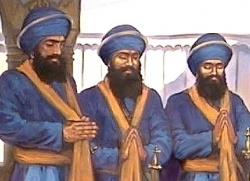Bhai Dharam Singh
Bhai Dharam Singh (3 November 1666 - 1708) had been a farmer when he answered a request of Guru Gobind Rai, which lead to his becoming one of the Panj Piare (the Five Beloved), the first five Sokhs to be initiated into the Khalsa). He was the son of Bhai Sant Ram and Mai Sabho, of Hastinapur, an ancient town on the right bank of the Ganges, 35 km northeast of Meerut (29°N, 77° 45'E) near modern New Delhi.
Joins the 10th Guru
Dharam Das, as he was originally named, fell into the company of a Sikh who introduced him to the teachings of the Sikh Gurus. He left home at the age of thirty in quest of further instruction. At the Sikh shrine of Nanak Piau, dedicated to Guru Nanak, he was advised to go to Guru Gobind Rai at Anandpur, where he arrived in 1698.
- Original Name: Bhai Dharam Das
- Became Bhai Dharam Singh on taking Amrit in 1699.
- Born into a farming family in Hastinapur on the banks of river Ganges on 1666 - the same year that Guru Gobind Singh was born
- Father name: Bhai Sant Ram Ji
- Mother name: Mata Mai Sabho Ji
- Akal Chalana: Attained Shayeedie at Nanded Sahib on 1708, aged 42 years.
- At the time of creation of Khalsa, Bhai Sahib ji was 33 years old
- Together with Bhai Daya Singh was sent to deliver the Zafarnamah to Emperor Aurangzeb
- On night of 7/8 December 1705 at Chamkaur with Bhai Daya Singh accompanied Guru Gobind Singh out of the fort.
| Panj Pyare |
Daya Singh
|
Offering his head
In 1699, during the historic Baisakhi congregation at which five Sikhs, responding to five successive calls of Guru Gobind Singh, Dharam Das was one of the five brave Sikhs who offered, one after the other, to lay down their heads. The Guru blessed them and called them Panj Piare, the five beloved of him. They were anointed as the first five members of the brotherhood of the Khalsa that was inaugurated on that day. Guru Gobind Singh then begged them to administer to him the vows of initiation.
Delivered Zafarnamah
Dharam Das, who, after initiation, became Dharam Singh, took part in the battles of Anandpur. He was in Guru Gobind Singh's train when Anandpur and thereafter Chamkaur were evacuated. He accompanied Bhai Daya Singh to the South to deliver Guru Gobind Singh's letter, the Zafarnamah, to Emperor Aurangzeb.
In Support of Prince Mua'zzam
During the war of succession following the death of Aurangzeb on 20 February 1707, Guru Gobind Singh, siding with Prince Mua'zzam in his quest for the Gaddi (throne) of the Mughal Empire, sent for the help Bhai Dharam Singh who with his small band of Sikhs fought in the battle of Jajau (8 June 1707). He was one of the Sikhs who accompanied Guru Gobind Singh to Nanded and was with him when Guruji physically departed from this world.
Back Home
Dharam Singh died at Nanded, where today a gurdwara preserves the memory of both Bhai Dharam Singh and Bhai Daya Singh, two of the original Panj Piare.
See also
References
- 1. Kuir Singh, Gurbifas Patshahi 10. Patiala, 1968
- 2. Chhibbar, Kesar Singh, Bansavah`nama Dasari Patshahiari Ka. Chandigarh, 1972
- 3. Santokh Sirigh, Bhai, Sn Gur Pratap 5uraj Granth. Amritsar 1926-37
- 4. Macauliffe, Max Arthur, The Sikh Religion. Oxford, 1909
- 5. Harbans Singh, Guru Gobind Singh. Chandigarh, 1966

